At first glance, Cornish hen vs chicken doesn’t have much difference. Even basically, the Cornish hen is truly a chicken. However, compared to chicken, the Cornish hen has some dissimilarities.
In the article below, I will classify Cornish hen and chicken in many fields, show how to use them in each case, and give some yummy recipes. You will find it surprising about the interesting features between Cornish hen and chicken here!
Since the information is completely free, please scroll down and digest it!
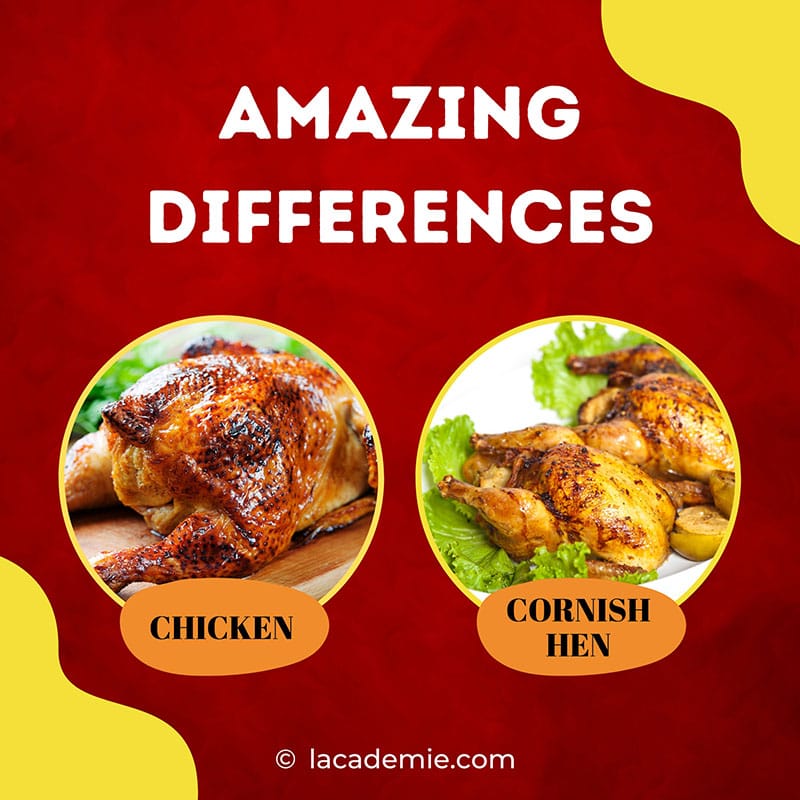
General Information About Cornish Hen
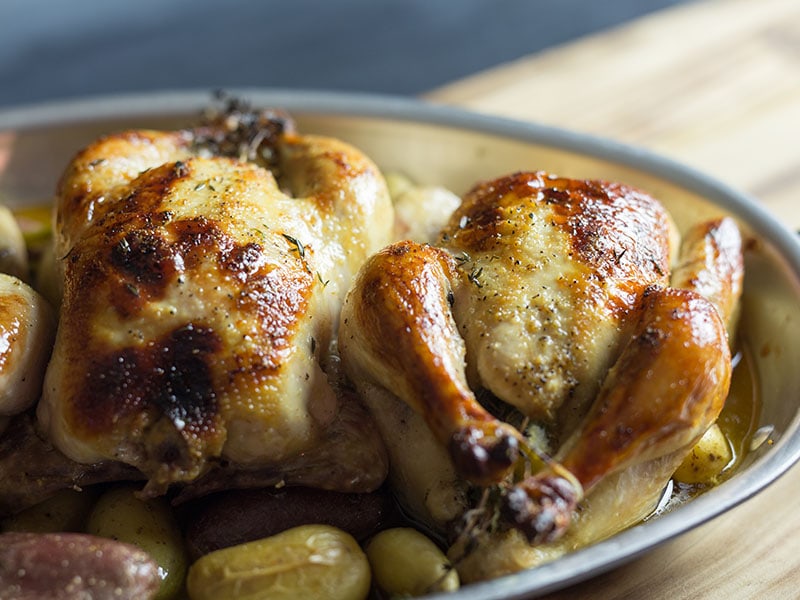
The Cornish hen is a mature female type of chicken, which originated in the US. It has a red, white, or black feather. People first developed this Cornish breed to be game chicken. (1)
However, the demand for food increased more and more later, people hybridized chicken with suitable characters for commercial use, and the Cornish hen was born.
Today, Cornish chicken appears commonly in many grocery stores and in family meals. One special thing is that the chicken sold in grocery stores are usually hybrids, i.e., rock Cornish hens. But the pack still has the “Cornish hen” label in general.
Some Common Things About Chicken You Should Know
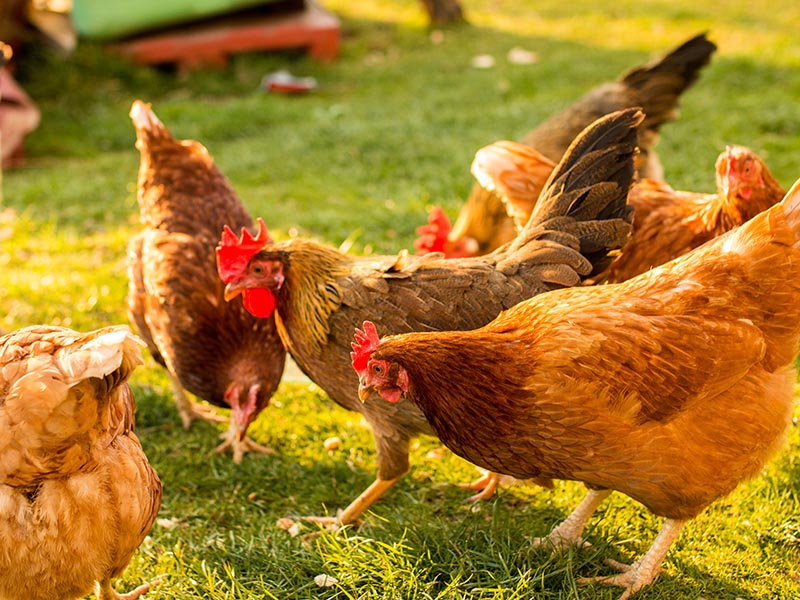
Chicken is a type of poultry, and its meat appears popularly in daily meals. It produces eggs and meat providing many nutrients for humans. Rock is a term for male chicken, while the name for mature female chicken is a hen. (2)
Chicken meat is a yummy ingredient for various recipes. Many even wonder how similar chicken is to tofu due to the former’s versatility. You can cook it by baking, boiling, frying, making soup, etc.
You also can use chicken eggs to boil, make a fried omelet, and use them as ingredients for making cakes.
There are many different types of chickens in the world. People feed them for many dissimilar purposes: breeding, meat production, or egg-laying.
The Cornish hen is one of those chickens raised solely for meat, and its ability to produce eggs is quite poor. To adapt to this commercial use, it has some differences from normal chicken. Let’s dive into the section below for detail!
There are many savory chicken recipes you can cook at home.
Comparison Between Cornish Hen And Chicken
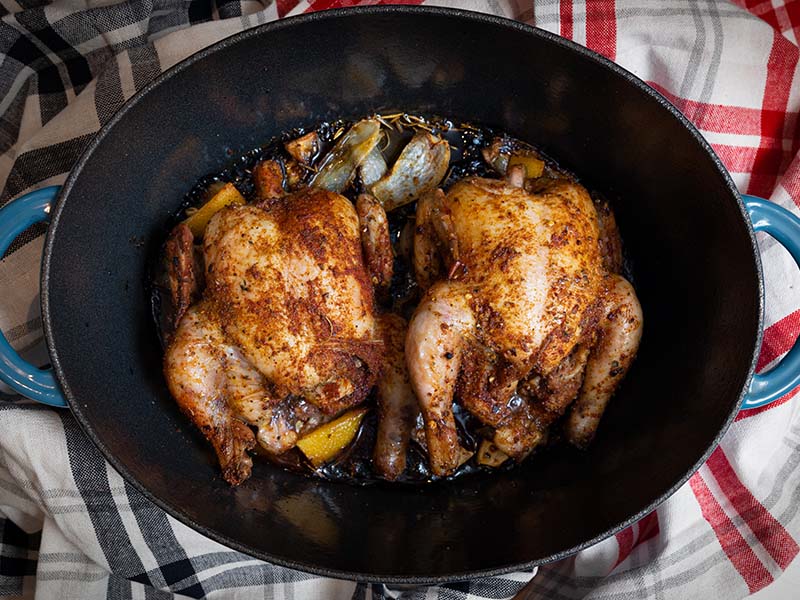
Before digesting a full comparison between Cornish hen and chicken, I made a chart of some short and simple information. You can read it and have a direction for the next long section:
Origin
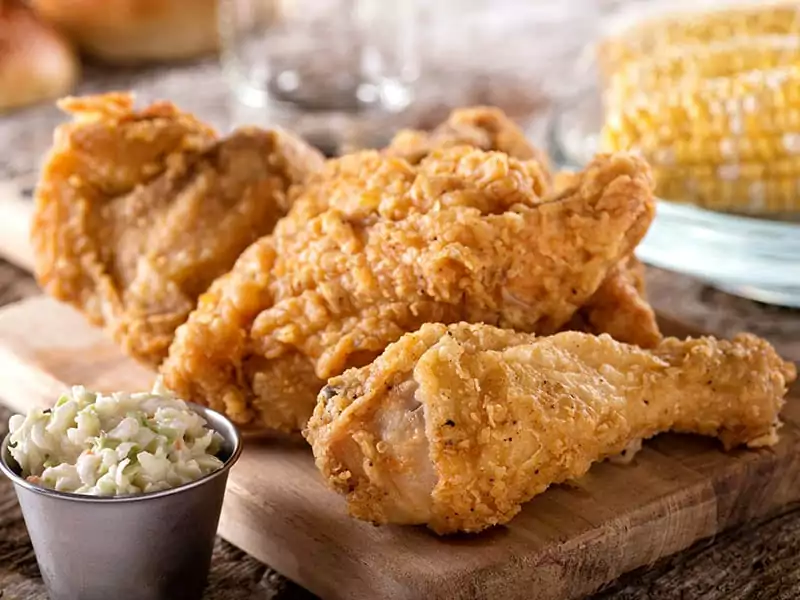
Firstly, the origin of chicken and Cornish hen has some dissimilarities.
Chicken is an ancient meat breed that appeared 7000 to 10000 years ago in Southeast Asia and Oceana. Red Junglefowl is the ancestor of chicken. Chicken is one of the favorite bird breeds producing eggs and meat for human life.
From Asia to Europe, you can find many amazing dishes made from chicken meat!
Cornish hen has only appeared since 1949 in the county of Cornwall in England. This is a type of chicken bred to produce meat, but it still keeps some original features of its Malay and Eastern blood. (3)
The Cornish breed has become popular in the United States and many other countries in the world since the 1960s. Now, you can find it commonly in many grocery stores.
Appearance
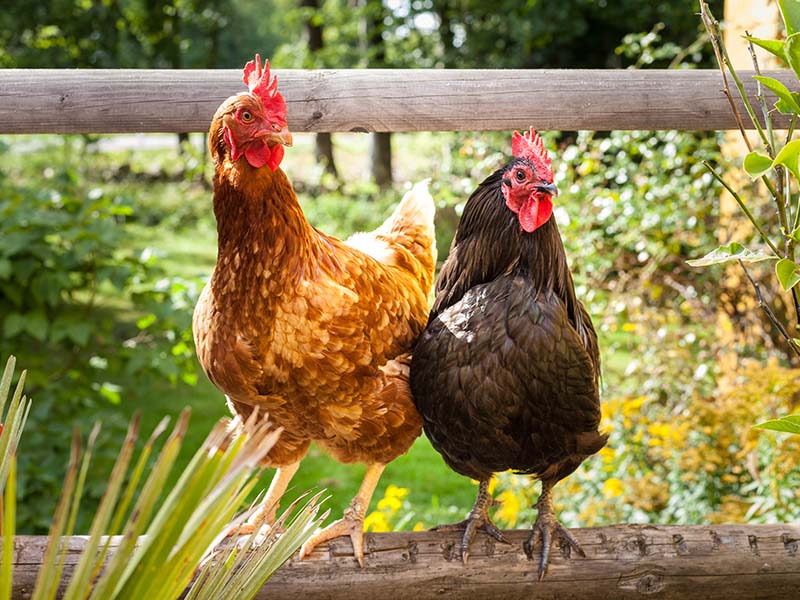
Second, I will come to the appearance of Cornish hen and chicken to show you the clearest recognition of these two types.
The Cornish breed stands out with a muscular body and large breasts. Its big chest results from the first hybrid purpose: to be game chickens. Overall, it has a heart-shaped form, gradually getting smaller towards the bottom.
Meanwhile, regular broiler chicken aims to produce both meat and eggs, it has a fairly balanced body and round shape. It doesn’t have a disproportionate body width like the Cornish’s.
If a normal broiler has long legs and large thighs, Cornish chicken has shorter legs and smaller thighs. This makes the Cornish hen’s appearance look deceptively heavier.
Another feature is in the feathers. The Cornish chicken has 3 typical colors: white, black, and red, or a hybrid color of the 3. The feather is short and close to the body. It also has dense and thick feathers because of the Cornish hen’s poor tolerance to cold.
The average chicken has long, smooth feathers and comes in various colors. Its hair density also varies from sparse to medium, but it is not as thick as Cornish hen’s feathers.
Next, skin color is also a very recognizable feature of the Cornish. Its body and legs’ skin are bold yellow. Regular chicken has a lighter skin color, even white.
Cornish chicken skin is also thinner and smoother because it is a kind of “young” chicken. Otherwise, other chicken’s skin has thickness depending on maturity.
A real view of Cornish hen so you can recognize what I mention below.
Size And Weight
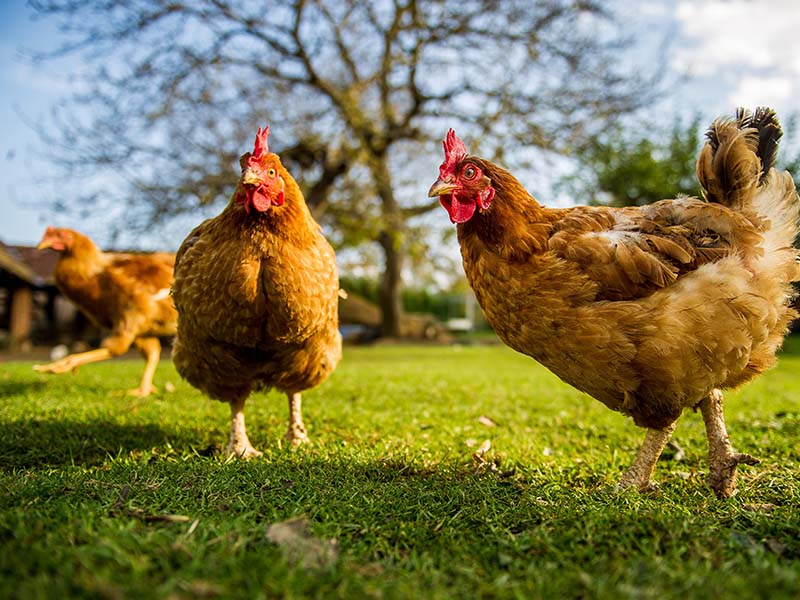
Thirdly, chicken and Cornish hens are different in size and weight. This feature even relates to the cooking styles in the following section.
A mature Cornish chicken can reach the same large size as another normal chicken. But people often slaughter it early when it weighs about 1 or 2 pounds to preserve better taste. It looks popularly small in size at the grocery or in the kitchen.
While people divide chicken’s weight into 3 classes, depending on the types of chicken. The broiler-fryer chicken weighs from 1.5 to 4 pounds.
The heavier is the roaster with a weight of 3.5 to 7 pounds. The last one is stewing chicken. It can reach from 4 to 7 pounds in weight.
Age
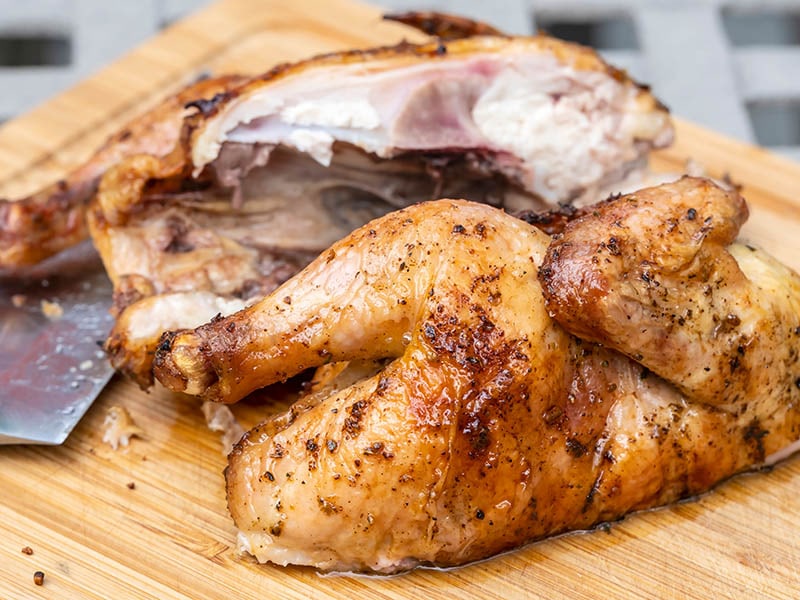
Fourthly, the age and maturity of the Cornish hen are also more special than the other types of chicken.
A Cornish is a type of bird capable of maturing faster than normal chicken. It has a growth rate twice as fast as other broilers.
It matures in about 4 weeks, and people kill it for consumption in the 5th week. At this time, the Cornish meat is at its best. After the 5th week, it will no longer retain freshness and sweetness.
In contrast, a chicken will take 8 or 12 weeks to mature, and it can live up to 10 years. Each type of chicken has a different maturity period: broiler-fryer is 7-13 week-old, roaster needs 3-5 months, and stewing chicken matures at more than 10 months.
Egg Laying
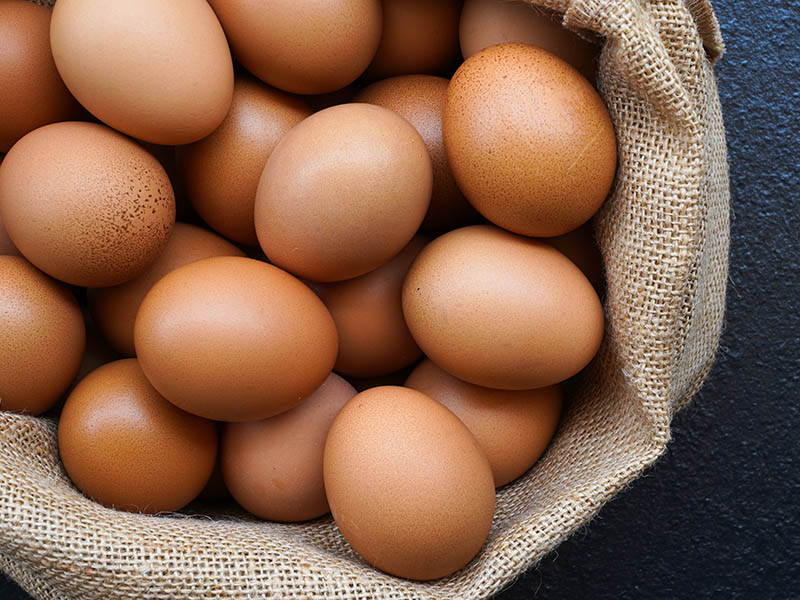
Fifth, because of the hybrid purpose, a Cornish’s possibility of laying eggs changes.
Cornish hen is not the breed for eggs. Its hybrid body with wide breasts makes the egg cavity small, so the eggs are tiny too. It also can’t lay more than 160 eggs per year.
Normally, a female chicken can produce 250 eggs around the year. Some people raise the chicken to lay eggs when it is an adult. After laying eggs for a long time, it can become the source of meat.
Taste
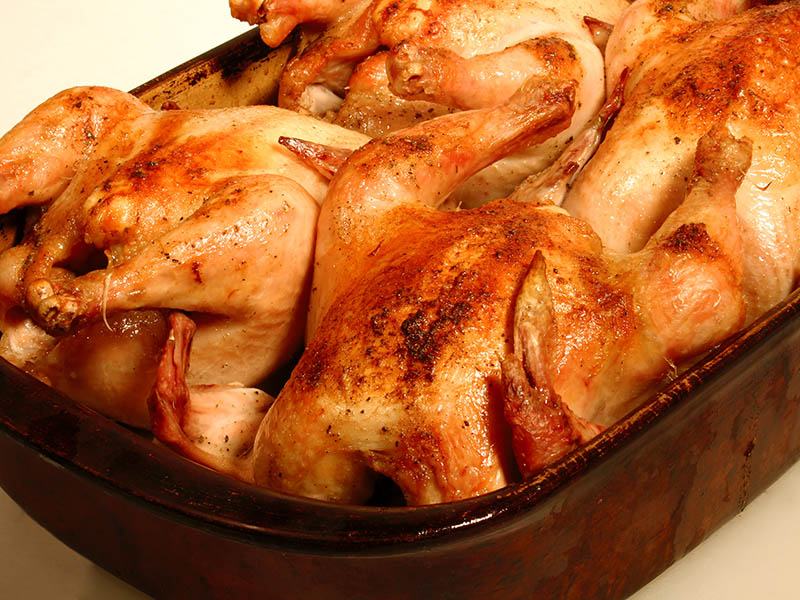
Sixth, in terms of the taste of Cornish chicken compared to normal chicken, I must say there is not much dissimilarity.
Even some types of white meat can taste like chicken. Then there is no reason why Cornish hen’s taste should be any different. Cornish hen at the end still is a type of chicken.
But sharing my deeper feelings, the Cornish meat is slightly more delicate. You also can find the taste of suckling pig somewhat in Cornish hen. The “young” meat keeps softness, moisture, and sweetness.
Chicken has a bolder original meat taste than the Cornish. Cornish hen meat can easily take in the marinade, so it delivers a richer flavor of seasoning than normal chicken meat does.
Your mouth will water after watching how to bake perfect Cornish chicken.
Cooking Styles
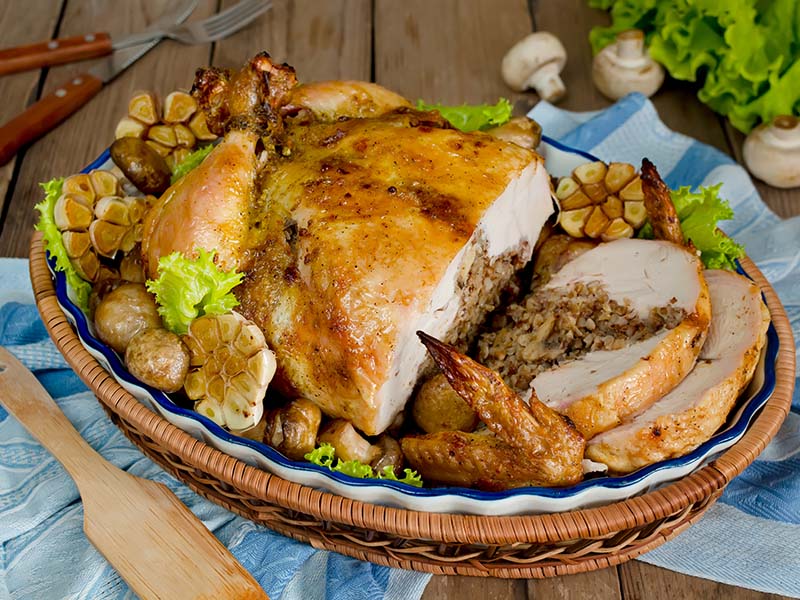
Sevenly, Cornish hen and chicken have different ways of cooking.
There are no limits on cooking a normal chicken. You can roast it whole, stuff ingredients inside the chicken, or fry it. Chicken is also large, so you can cut it into tiny pieces or cubes for some recipes.
However, cooking styles for Cornish chicken meet some limitations. Due to its small size and structure, it is hard to cut or divide it. If you cut it tiny, the skin and bones are prone to crumbling and falling apart.
Besides, the Cornish allows you to cook a whole. It will be hard for you to cook a whole average chicken. Imagine how difficult it would be to roast a 7-pound chicken?
In addition, there are some points to note. For stuffed Cornish chicken, you should do it slowly and carefully so as not to tear its skin. Cornish hen’s skin, as I mentioned below, is not as thick as a normal chicken.
For the oven or air fryer, you can bake Cornish chicken at the same 350° F as chicken. The banking time will be reduced by 10 – 15 minutes as it can be well done fast.
Serving
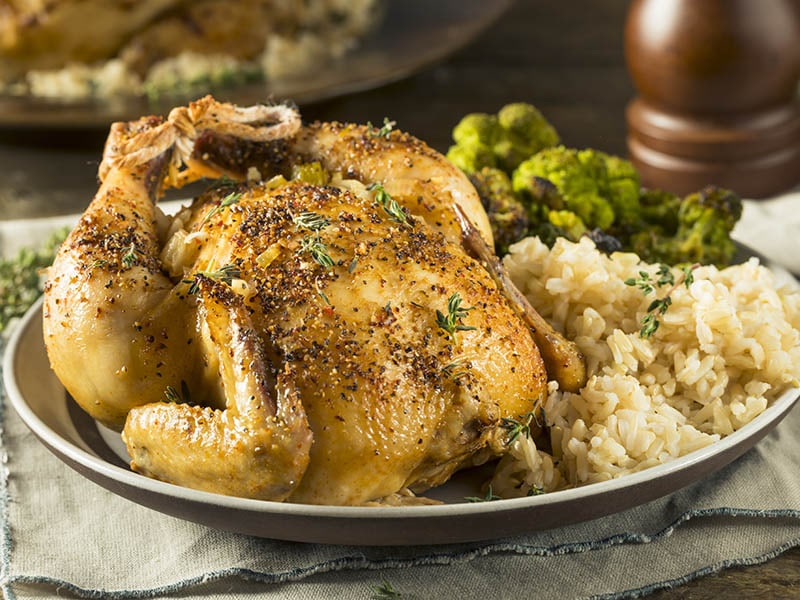
Eighth, I want to mention the difference between serving Cornish hen and chicken.
Because of its relatively small size, people usually serve a whole Cornish with suitable side dishes. Each chicken is an individual portion. It looks more perfect than other chicken dishes when serving because it can fit on a plate.
Sometimes, people also cut it in half or, for those slightly over 2 pounds, cut it in 4. A dinner guest can consume a baked Cornish entirely, so one Cornish chicken is not suitable to serve many people at the same time.
Cornish hen’s eye-catching whole form presents gorgeously in elegant parties or show-stopping presentations. Sometimes the Cornish is also a great substitution for Turkey or average chicken on Thanksgiving. (4)
In contrast, there are multiple ways to serve chicken: a whole in a crowded party or tiny pieces in a family’s daily meal. Its common serving is to cut the chicken into smaller portions for easier enjoyment.
Moreover, you also can save a lot of money on buying chicken for large numbers of people because of its big size. Instead of spending money to buy a dozen small Cornish chickens, you can buy 1 to 2 normal chickens to serve 12 guests.
Packing
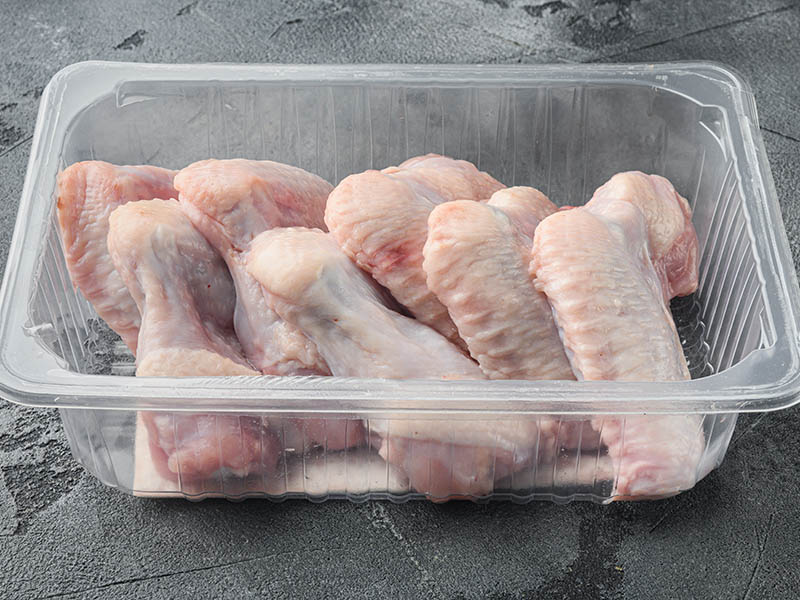
Ninth, not only is the dissimilarity in serving, but packing is also an obvious point to distinguish Cornish hen vs chicken.
Chickens for sale at the grocery are usually a whole, a half, or separated parts such as wings, thighs, breasts, etc. You can also find boneless or skinless chicken portions sold in supermarkets or groceries.
Meanwhile, you only can find a whole Cornish hen sold. You have no other option!
Price
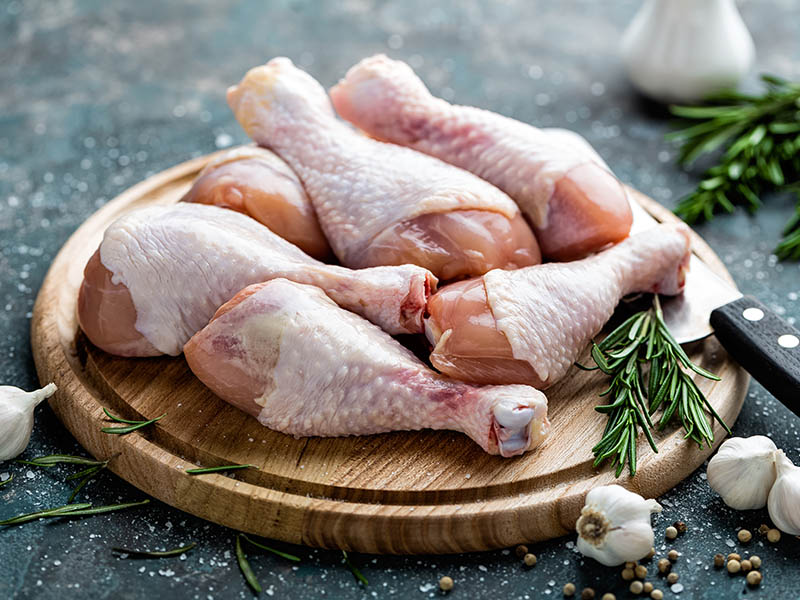
Tenth, the gap between two chickens’ prices is also worth mentioning.
Although Cornish chicken has a faster growth rate and shorter breeding period, the raising is not widespread. Due to its low level of production and popularity, Cornish hen is usually quite expensive, whether raw chicken or cooked one.
A normal chicken has a wide range of prices, but it is often cheaper than a Cornish. However, on special occasions, try the more expensive one to feel the more tender cuts of meat and the fancier presentation.
Nutrition Facts
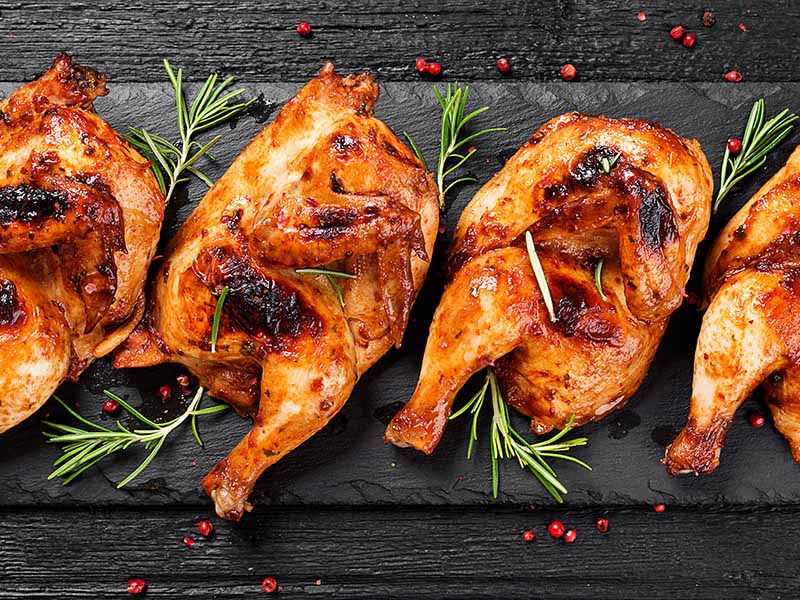
Finally, in terms of nutrients contained in the two types, there are some similarities and some dissimilarities.
Because they are all-white meat, they contain low fat and are high in protein and calories. It benefits those who have heart-related diseases, obesity, and diabetes,…
Chickens or Cornish chickens have high niacin content, which is good for brain function and helps to reduce cholesterol. They also have many vitamins such as A, B, D, and B12,… which are good for eyesight and bones.
The difference between them is in the amount of these nutritions. Since Cornish hens are lighter in weight and smaller in size, their fat is less while calories are higher than the average chicken.
The proportion of white meat in Cornish hen is also higher than in chicken. Similarly, the dark meat amount in chicken is more than the Cornish. In case you wonder, fat content is one of many aspects that set dark meat apart from white meat chicken.
Dark meat contains a lot of essential riboflavin for skin, nails, hair, and cellar production, but it is also higher in fat. So, eating Cornish is healthier than eating chicken!
Can I Replace Chicken With Cornish Hen And Vice Versa?
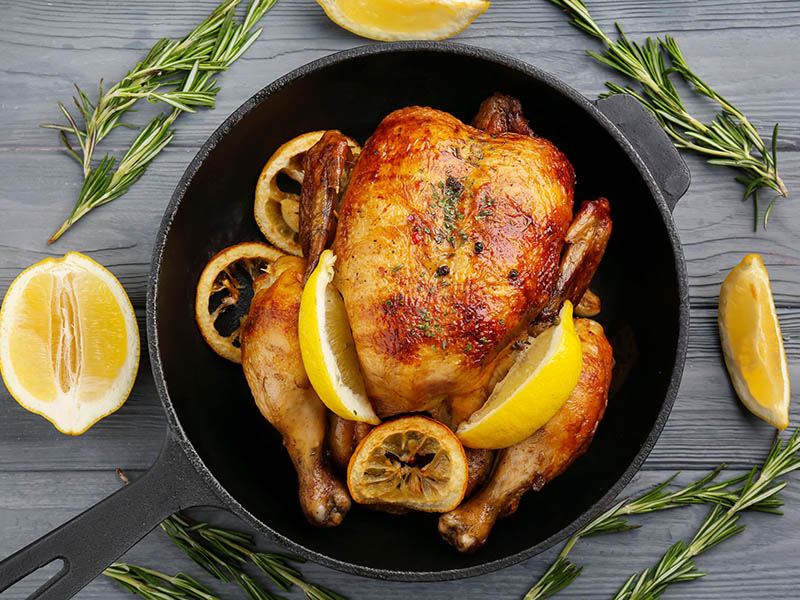
With so many dissimilarities in size, weight, and taste, you probably wonder if Cornish meat can replace chicken meat in a recipe? Will it change the taste of the dish? My answer is:
A Cornish hen is actually a chicken, but it is smaller and a young type of meat. If you are not too attentive, the taste of Cornish chicken is no different from the taste of a regular chicken piece. So it is possible to exchange the two types of chicken in a recipe.
There are some points you should notice when replacing them. First, when using Cornish chicken in a regular chicken recipe, you should cook it for a shorter time. The Cornish meat will reach the proper doneness and won’t lose the flavor.
Secondly, if you want to have a rich seasoned dish, choosing Cornish meat will be better. Thirdly, for parties with chicken as the main dish, you should consider cooking Cornish chicken instead of a normal one because it will bring more wonderful taste and sight.
Fourthly, some recipes for individual parts are difficult to apply with Cornish chickens’ parts because of their small size. You should use normal chicken in recipes using separated parts, distributed pieces, or deboned meat.
FAQs
In case you still have some questions about Cornish hen, I have compiled some further short information below. Find out what you are not clear about.
Cornish Hen Is A Small Chicken Version
In many comparison fields, the Cornish hen still maintains the characteristics of a broiler chicken. Even so, it has a fresher taste due to being slaughtered at an early age.
The difference in size, as well as some physical features, make the cooking, serving, and packing of the Cornish different from chicken. Cornish hen is becoming more and more popular these days and can be substituted for chicken in recipes. But the cost is much higher.
Through my article, you can tell what is a Cornish hen and what is chicken, right? I have suggested some interesting recipes. If you found the information helpful to your cooking, don’t forget to like and spread it to more readers!
Wish you will have many delicious meals with Cornish hen!
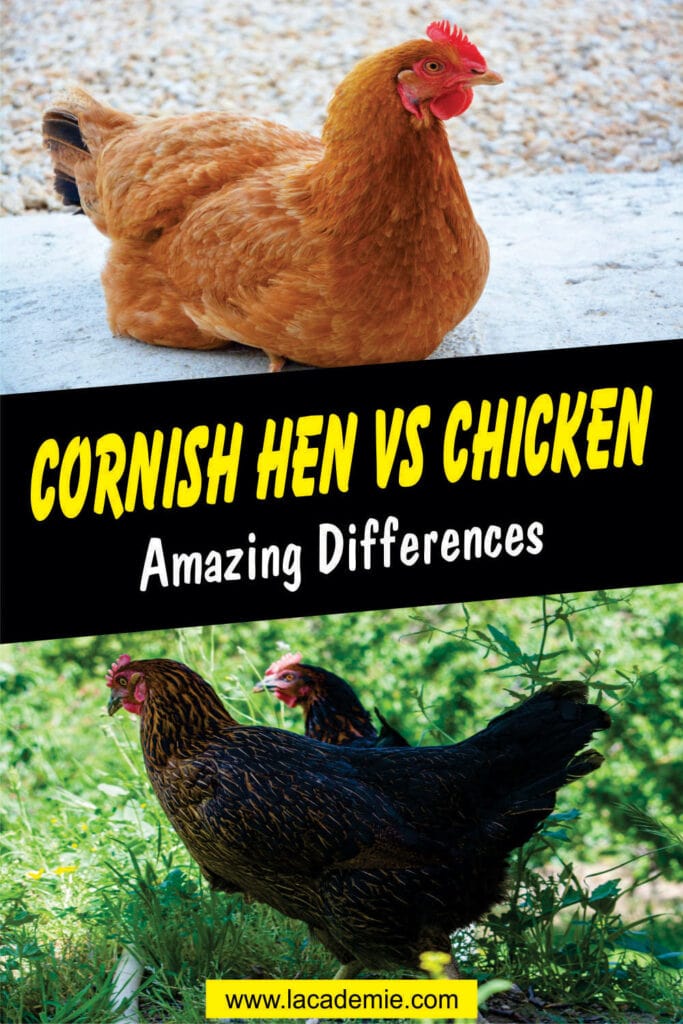
References
- The Livestock Conservancy. 2022. Cornish Chicken – The Livestock Conservancy.
- Afs.okstate.edu. 2022. Poultry Breeds – Cornish Chickens — Breeds of Livestock, Department of Animal Science.
- Animal Corner. 2022. Chickens, Hens & Roosters – Facts, Information & Pictures.
- Foodchamps.org. 2022.


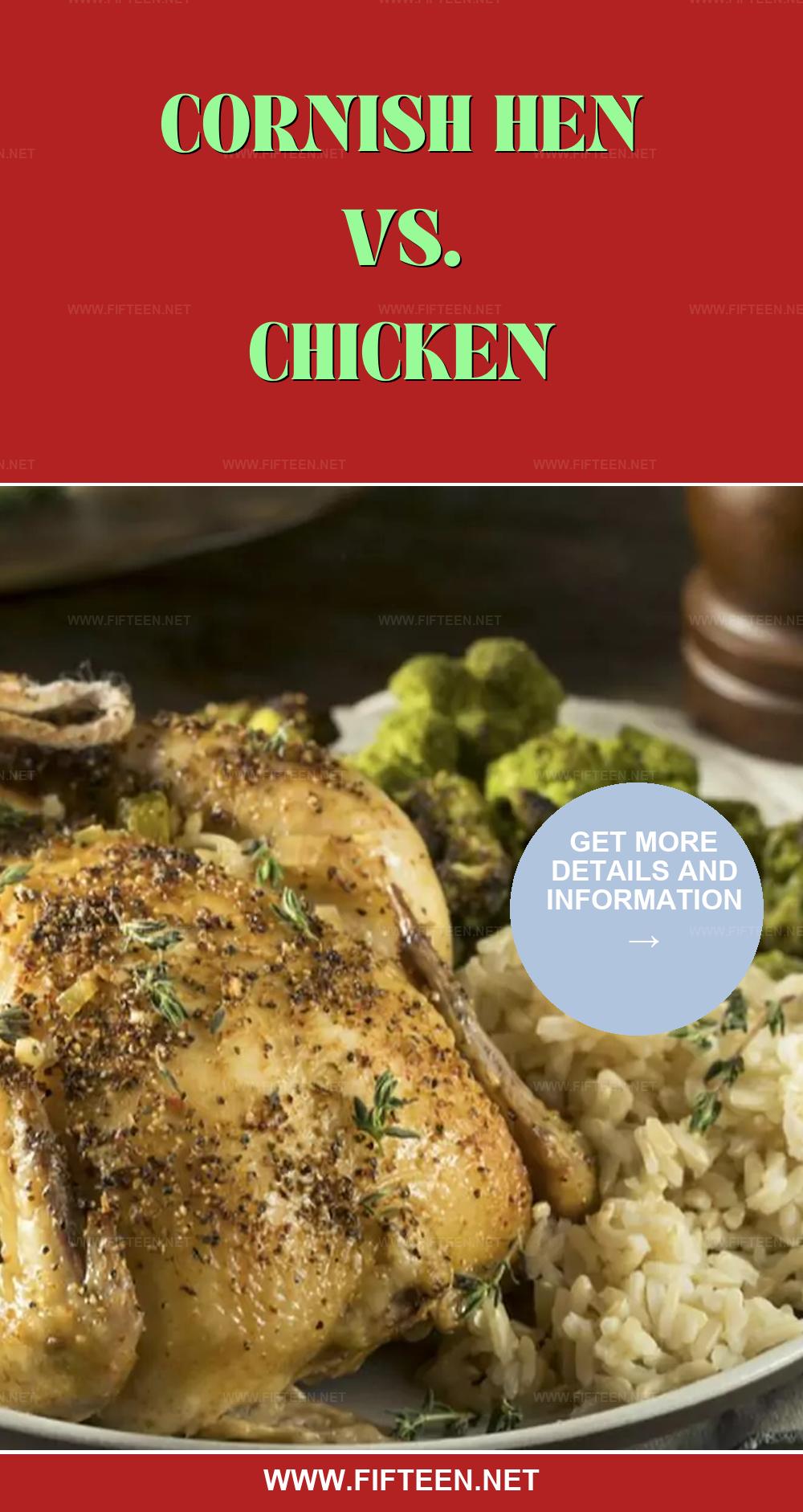
Jamie Scott
Editor in Chief, Senior Content Writer
Expertise
Home Cooking, Meal Planning, Recipe Development, Baking and Pastry, Food Editor, Cooking-video Maker, Western Food Evaluation Expert
Education
Le Cordon Bleu College of Culinary Arts
Local Community College, New York, NY
Jamie Scott is a skilled culinary expert and content creator specializing in Western cuisine. With over 15 years in the culinary field and formal training from Le Cordon Bleu, Paris, Jamie deeply understands how to blend nutrition with delicious flavors. His passion for cooking matches his commitment to making healthy eating accessible and enjoyable.
On Fifteen.net, Jamie brings a fresh perspective to classic dishes and beverages, offering readers insightful recipes, cooking tips, and a fresh view on meal planning that emphasizes taste, health, and simplicity.